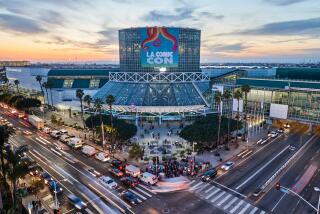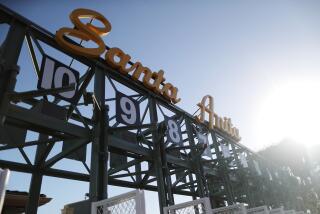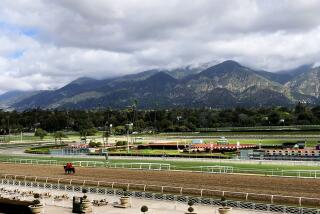Fairgrounds Development: Self--Sufficiency Is Goal : Latin Cowboys Help Fair Say Adios for ’85
With the brassy strains of mariachis and the scent of hot churros for sale from sidewalk stands, the Orange County Fair closed the doors on what could be a record-breaking year Sunday in an afternoon that blended the all-American fair with a dose of south-of-the-border cowpoking.
The Gran Charreada, a Mexican-style rodeo, attracted hundreds of Latino families to the blistering heat of the main grandstand, testimony to promotional efforts aimed at drawing a broader spectrum of people to push this year’s attendance close to a record.
Thursday, Friday and Saturday all set one-day attendance marks, and overall attendance at the 10-day fair was expected to hit 360,000, close to the record of 368,903 set in 1981. Gross receipts from ride tickets already were up 45% over last year.
“Overall, I’d say it went very well,” said fair General Manager Norbert Bartosik. “We’re going to be way over last year at this point, and we’re looking for it to top out at 350,000 to 360,000, and we’re very pleased with that.”
Sunday’s charreada, a celebration of the American rodeo’s Mexican roots, also represented an attempt to attract other kinds of families to the fair, Bartosik said.
“It was a chance for us to try to invite some of the minority communities to the fair, and let them know that we’re concerned about them, that we want to offer them something at the fair, too,” he said. “We realize the Orange County-Santa Ana area has a very strong Hispanic population, and we thought that this might be something . . . for them.”
Mexican Flags Cheered
Latinos filled nearly two-thirds of the grandstands, stomping their feet to the tunes of the mariachis, cheering the red, white and green of the Mexican flags and hooting their approval at the Mexican charros in their enormous sombreros.
“Our bull riders are bull riders, let me tell you. There’s no comparison!” said Tony Carranza of Santa Ana. While the American rodeo cowboys at Sunday’s event were riding the bulls and broncos one-handed, they only had to ride for eight seconds. Under Mexican rules, charros ride two-handed, but must hold on as long as the animal is bucking, Carranza explained.
“The people go for these, whenever they’re around,” he said. “You go to Pico Rivera, see the charreadas there, you’ll see. They’re all crazy!”
Paco Valenzuela, well-known Mexican rodeo announcer, provided a running commentary on Sunday’s events in Spanish.
‘For the Heck of It’
“I think the rodeo and the Mexican charreada have a good linkage, because they have many of the same things,” Valenzuela said. “The big difference is in American rodeo the cowboys are going for money, and in the Mexican charreada they’re going for sport only. What do you say? For the heck of it.”
Martha Martinez of San Juan Capistrano said she came because her husband, who only recently came to the United States from central Mexico, had told her so much about Mexican rodeos. “I’ve never seen one, even though I’m Mexican, and so for me, this is a good chance,” she said.
Behind her, an elderly man sat quietly through the heroics in the arena, silently mouthing lyrics to the gleeful rhythm of the mariachis.
Fair officials launched other promotions this year aimed at attracting the handicapped, senior citizens and others who might not otherwise go to the fair.
Key to Success
“I think the whole key to our success this year was a whole bag of promotions, as opposed to a bag of tricks,” said Bartosik. Among them:
- The first midway discounts in the fair’s history. They included 50-cent ride promotions on both Friday afternoons of the fair (attracting 13,000 people July 12 and 32,000 this past Friday) and a $6 unlimited ridership ticket on Tuesday through Thursday that was also well received.
- Admissions discounts, including offers of a $1 discount on the $4 admission fee to groups of 25 or more. A total of $20,000 in group admissions were sold, four times the amount sold last year. A special Costa Mesa Day on Monday offering $1 discounts to adults and 50-cent discounts to children who could prove they live in Costa Mesa attracted more than 1,000 visitors.
Total paid attendance as of Sunday morning was up 6.5% over last year, and overall attendance was up 12%, Bartosik said. While revenue from carnival tickets was up at least 45%, parking and admissions revenues were expected to total $1.2 million to $1.3 million, he said.
“We’re above breaking even at this point,” he said. “How far above, we can’t say yet. We’ve obviously had a very successful year.”
More to Read
Sign up for Essential California
The most important California stories and recommendations in your inbox every morning.
You may occasionally receive promotional content from the Los Angeles Times.










